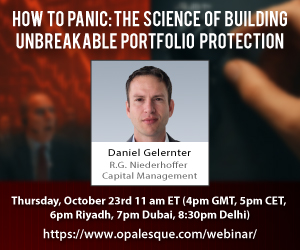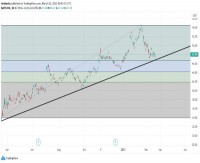|
Structured Products - the most suitable, efficient and fittest? Are Islamic Investors the new Fertile Ground for conventional structurers looking to exploit a lack of sophistication? This is a question that few are brave enough to ask but should come to the minds of almost everyone who is not overawed by the next best retail product offering multiples of LIBOR returns except for very specific (and historically rare) occurrences. While conventional structuring desks are downsizing (and some investment banks categorically exiting the structured products business) this sector within the Islamic Banking industry is undergoing a relative boom. Despite the fact that the motives, underlying exposures, fees/costs, backtests, and ultimate delivery of these products is being challenged elsewhere. Some of the reasons are very subtle but very telling: in most conventional investment banks Islamic finance is merely a branch (or a desk) of other groups, usually Structured Product and Securitizations. Typically, bankers with significant backgrounds in conventional securitization and an interest in Islamic Banking are tasked with structuring and issuing sukuk. This has of course developed into a discipline in and of itself. Thus, those with a background in conventional structured products have merely to figure how to deal with (and oftentimes circumvent) Shariah constraints on top of the legal, tax, and regulatory issues they already deal with and the pricing, hedging, and willingness of traders and risk managers to take on the residual risk, matters that always come with the territory. Hence, being a branch of Structured Products and one that has managed to survive while other areas are drying up, it makes sense that conventional bankers should be falling all over themselves to come up with the next best Islamic Structured Product. In a sense this also explains why sukuk is enigineered to fit into a fixed income device - when it rightfully belongs as an equity-hybrid instrument. The conventional structured product industry has most certainly had a bumpy ride. Issuance had grown rapidly over the years, with Equity Exotics always leading the way and Fixed Income making major leeway from 2001 onwards with the issuance of a large amount of CMSlinked notes and later range accrual and even autocalls, the majority of which having been placed with retail accounts. However, as early as 2005, there were growing pains. Investors, having bought some highly complex instrument backed by AA financial institution (sometimes on margin) wanted to know why their valuations were down and margin calls were already being made. Structurers in Europe were keen to show that many of the poor valuations of the product that they had sold were not due to the structured cashflows being intrinsically bad, but instead the issuers' credit spreads had widened. Most structured products in Europe are delivered via private banks to HNW individuals through Euro-MTN (medium term notes) platforms, legally efficient means for large financial and other institutions, sometimes called "frequent borrowers', so they could issue small notional notes with bespoke structures. In each such structure, the issuing institution, be it a high quality KFW, EIB, or WorldBank or a lower rateed entity such as RBS, Barclays Capital, or Lehman Brothers would have their Treasury department - which manages the funding needs" enter into a swap with the underwriting bank's exotic desk in order to hedge it. Treasury merely pays LIBOR plus or minus some attractive spread to compensate Treasury for their minimal efforts. Valuations consequently can change based on the credit quality of the issuer or the change in valuation of the hedging exotic swap. Nonetheless, issuance continued with 2005-2006 being bumper years for all structuring desks, allowing them to grow and move further down the value-chain. Penetration was high and some regulatory regimes aided the process by being overtly lax. An industry observer in the research department of a large city bank was particularly peeved to learn his mother had walked into her local bank in Germany and bought some CMS-steepeners, mostly because of the higher first coupon and the amazing returns in the backtest. The results were as should have been expected. In Singapore, exotics traders would admit shock that the products similar to those they regularly traded and risk-managed were being offered in brochures to the general public (in vaguely incredible terms) without much in the way of disclaimers. In other countries, the fact that these products are offered only to high-net worth individuals with many disclaimers proved little disincentive and exotics traders (and their delivery channels) worked overtime. Although credit spreads widened during the same 2005-2006 period, this was only a small hint of what was to come. Many structures did exceptionally poorly during the crisis. Spreads generally widened further (or there were defaults as was the case with Lehman Brothers). With vanilla products being hard to price, structured product became incredibly hard. Obviously there were some winners, but the amounts of money lost were cause for retail clients to pull back entirely from the market. With their fingers burned, retail acounts lost most demand for any exotic structure. Several structuring desks were shut down (tellingly some were closed well in advance of the actual market downturn, they knew what was coming). Despite the exists this did not cause structuring as an enterprise to cease. Clients still had some appetite for simple structures (i.e., delta-one, simple funds whether they were algorithmic, indexation, replicants, etc). Structuring desks did not remain stationary although retrenchment continued on the conventional side and few (if any) retail launches to boast in the past year or so. Nevertheless, there is still resilience in Islamic finance and Islamic structured products are still making headlines in the GCC and SouthEastAsia.
Structured Product: Sold on a promise but often misunderstood In reality, most clients are far less sophisticated and they have no view of their own, until the view is marketed to them. The product is sold merely because it looks cheap and it backtests well (i.e., if you could have bought the same product every year over the past 20 years without fail you would have made these stellar returns). Products sold on a backtest are particularly poor since they usually involve buying a risk that is cheap now because of market-wide liquidations, but that risk is likely (if not guaranteed) to revert. Backtests, in all their glory, are a very poor form of statistics. Some clients of course do exceptionally well with structured products. Those with a view are paying up for the ability to leverage that view without having to have full-time staff to roll repos, find securities to short, etc. As a structure it can be a very efficient way of encapsulating specific views of the market. Even those who were sold products which they did not clearly understand could have done exceptionally well, depending on the entry point. However the prudential aspect must focus on the many who do not understand what they are buying, allocate disproportionate ammounts of their total savings, and exacerbate the problem by trying to liquidate their position in a down market. Structured products, by design, are more opaque than their vanilla counterparts. Customers and intermediaries oftentimes barely understand the cashflows let alone the way that returns are calculated or delivered. This is especially true about valuations. Margins are sometimes explicit, but oftentimes reserves (for re-hedging costs) and sales credits are completely hidden. Smart buyers, of which there are some, will ask for multiple quotes and many structuring desks are used to reverse engineering a structure just so they can reprice it. Most retail users are sold these products by intermediaries (private banks or other financial entities) who are generally incented by the distribution fees (made explicit, to be fair) and consequently there is little shopping around done by them. In times of trouble structuring desks have made little actual commitment to make secondary markets. There are exceptions and there are traders who will buy and sell structures (usually those underwritten by their own exotics desks) generally at relatively wide margins. With valuations down, clients will turn to their private banks who in turn will ask for bids to liquidate the structures. With little commitment to make a secondary market, structuring desks may actually make larger fees in the cleanup phase of structures-gone-bad than during the original sale.
Islamic Structured Product Meanwhile, structured products are still front page still while the rest of the world is unwinding. Perhaps Islamic investors, not having invested in structured products in the past, were not scathed by the recent falls in valuations. Perhaps the marketing is key, with structured products finding a home in eager-to-innovate Islamic banks. Certainly the announcement in July 2009 of DIB's 1year Crescent Commodity Twister Strategy, a CPPI on a Long/ Short index shows that structured products are alive and well in Islamic Finance. One can't help notice that Islamic investors flock to structures that have long been disfavoured in the conventional world. This has happened before, when a product loses favor in conventional finance it is wrapped for delivery to Islamic finance. This is not confide to structured products though, there are cases of suboptimal real estate, quasi-distressed projects, highly-adventurous venture capital, downward-sloping equities. They all fund a new life as Shariah compliant vehicles (often garnering attention as trail-blazers, first-of-its-kind, unique). An example here is CPPI or Dynamic Strategy, something that has become prevalent in Islamic Finance. CPPI (Constant proportional portfolio insurance) is not a bad structure, being a dynamic way of delivering principal protected investments with a good deal of upside potential. However, dynamic structures are hard to explain to clients and - if they are sold - they are even harder to explain to clients ex-post when they want to know why they will only expect to get 0% for the entire lifetime of their investment and the structurer must explain that it is not because equities have fallen but it is because bonds have rallied. Consequently, even in good times, CPPI has not sold that well in the conventional world. A further problem is something known as gap risk, a kind of insurance wrapper for CPPI structures (insuring the breakdown of hedges) is now almost impossible to source. The recent crisis has shown that assets can gap significantly and the sellers of gap-risk insurance have been called in many cases to help cover losses. Nowadays, almost nobody wants to underwrite this risk and CPPI issuance has come to a halt. In the Islamic banking world though, gap risk is somewhat more of an anomaly and in fact insuring it may not result in a shariah-compliant dynamic strategy. So while the rest of the world sits back, the Islamic world is moving headlong into structured product. The marriage is not necessarily optimal. |
Opalesque Islamic Finance Intelligence
Featured Structure Structured Products - the most suitable, efficient and fittest? Nikan Firoozye, Ph.D. |
|





 RSS
RSS










